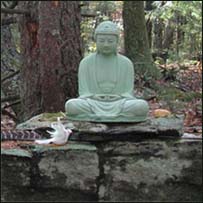|
|
 |
Please support Dharma Seed with a 2025 year-end gift.
Your donations allow us to offer these teachings online to all.

|

|

|
The greatest gift is the
gift of the teachings
|
|

|
| |
|
Dharma Talks
|
2016-10-26
Dharma Practice and the Election
65:55
|
|
Donald Rothberg
|
|
|
We often say, "Let no part of your experience be left out of your practice." Okay-- how about "practicing with the election"? We explore 5 ways to focus our practice in this context, through (1) practicing with views and positions; (2) developing empathy; (3) working with difficult emotions; (4) seeing the world through the lens of our practice; and (5) acting.
|
|
Spirit Rock Meditation Center
|
|
|
2016-10-20
Fourth Noble Truth
50:33
|
|
Shaila Catherine
|
|
|
Shaila Catherine gave the fourth talk in the five-week series "Four Noble Truths." This talk discusses the Fourth Noble Truth, the path leading to the cessation of suffering and known as the Noble Eightfold Path. We must know this path and actually travel it. This practice allows us to live a life that is noble and upright, and helps us distinguish between that which is wholesome (which leads to ending of suffering) and that which is unwholesome (which leads to more suffering).
|
|
Insight Meditation South Bay - Silicon Valley
|
|
In
collection:
Four Noble Truths
|
|
|
2016-10-20
The Fourth Foundation of Mindfulness
59:51
|
|
Sally Armstrong
|
|
|
The Satipaṭṭhāna Sutta (usually translated as the Foundations of Mindfulness) offers a complete description of the practice of mindfulness, beginning with the direct awareness of the breath and the body, progressing through mindfulness of vedana or feeling tone, to the more subtle object of the Third Foundation, mindfulness of mind states. The Fourth Foundation of Mindfulness represents the culmination of this series of practices, and can be seen as a direct pointing, again and again, to the possibility of freedom through direct awareness of where we get caught, and how to turn the mind towards liberation. This talk is an overview of the practices of the Fourth Foundation, which can be seen as both the last in the sequence of practices, and as a progression in itself. It also covers how the Fourth Foundation can be skillfully interwoven into our practice of the other foundations.
|
|
Insight Meditation Society - Retreat Center
:
Three-Month Part 1
|
|
|
2016-10-19
Empathy 2
1:11:34
|
|
Donald Rothberg
|
|
|
After a review of last week's overview about the nature of empathy and empathy practice, we explore working with some of the challenges of such practice, and what a high level of empathy looks like.
|
|
Spirit Rock Meditation Center
|
|
|
2016-10-17
Buddhist Studies Course - Understanding Sensuality - Week 5
1:28:22
|
|
Mark Nunberg
|
|
|
We have now completed half of our course examining our experience of sensuality. As we have begun to reflect on the limitation of sense experience we want to specifically look into the limitations of what we might consider wholesome experience. What danger, if any, is associated with wholesome experiences? At the end of MN 13, The Discourse on the Great Mass of Stress the Buddha uses the example of meditative peace as a sense experience with the allure of gratification, with drawbacks and with an escape. So if even the deepest states of meditative peace have drawbacks what about the pleasant wholesome states that our minds are still dependent on? Are these experiences a set up for disappointment, stress and suffering? What has our experience taught us? Let's notice the ephemeral quality of our wholesome moments. Are they stable enough to provide lasting satisfaction?
|
|
Common Ground Meditation Center
:
Buddhist Studies Course - Understanding Sensuality
|
|
|
|
|
2016-10-14
We Are Stronger Than We Know: The Truth About Trauma
30:14
|
|
Ayya Medhanandi
|
|
|
Practice wise attention, train in right view, and see things as they are. Touch the fires of trauma and rise from their ashes. Attend to ancient hurts with conscious full-hearted forgiveness. As we disown these old karmas, we augment the higher frequency and pure vibration of loving-kindness. It’s unconditional and ownerless. So the inner fires gradually cool and reveal the Unconditioned. Seeing the truth of the moment we undo all the untruths of the past.
|
|
Sati Saraniya Hermitage
|
|
|
2016-10-13
Kamma and equanimity
57:58
|
|
Sally Armstrong
|
|
|
There are two main aspects to mental factor of equanimity. The first is a vast and spacious mind, within which all experiences can arise and pass without disturbance. The other is understanding deeply the nature of reality and experience, so the mind is steady in the face of changing conditions. In Buddhist teachings this includes the understanding of kamma, the teachings of cause and effect. This important teaching is not about blame and judgment, but rather an empowering instruction on the possibility of understanding the natural laws of cause and effect, and how to train the mind and heart to reduce suffering and increase well-being for oneself and for others.
|
|
Insight Meditation Society - Retreat Center
:
Three-Month Part 1
|
|
|
|
|